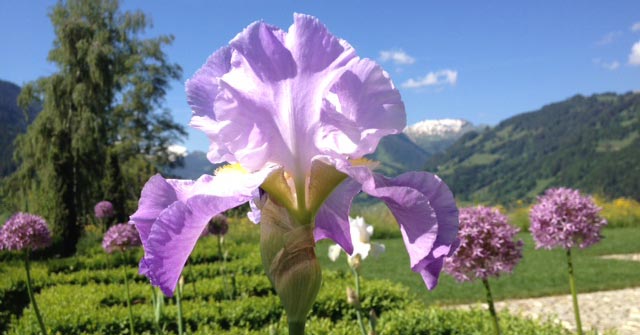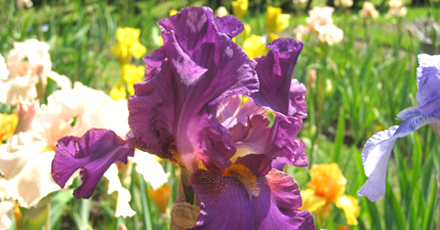History of British Irises
Early Years
Arthur Bliss is one of the first British hybridisers of note, beginning his work in 1902. Ann Milner holds the National Collection of Bliss Irises, featured recently on the BBCTV series Great British Garden Revival.
The British Iris Society was formed in 1922. One of its founding members was John Rikatson Dykes (also a founding member of RHS). He instituted the Dykes medal that is awarded for the most outstanding iris seedling selected after trials.
Cedric Morris, renowned artist and hybridiser, began breeding irises in the 1930’s and continued for over thirty years, registering his last introduction in the early 1960’s. Sarah Cooke is actively involved in researching and reintroducing many of these historic irises. She holds the National Collection of Cedric Morris Irises that featured prominently at Chelsea in 2015.
The Golden Years
The 1950’s witnessed what was the start perhaps of the golden years of British hybridising.
Harry Randall, a keen grower and breeder of Tall Bearded Irises visited the Unites States in the course of his business and made contact with keen iris growers, bringing back many gifted varieties which he then used successfully in his own hybridising programmes. He won three Dykes medals.
Fothergill, Randall’s arch rival, another celebrated breeder of the time and four times Dykes medal winner and Leonard Brummitt , awarded two Dykes medals, were noted hybridsers of the 1950’s and early 1960’s.
At that time George Preston, keen lover of Tall Bearded Irises, was responsible for having a number of Tall Bearded Iris beds planted at Kew. These were to prove an inspiration to many, not least Bryan Dodsworth whose interest was first excited by the Kew Bearded Iris Display beds.
Recent Times
During the 1970’s and 1980’s Britain was blessed with talented hybridisers working with a number of different irises: ‘talls’, shorter border and dwarf bearded, beardless varieties, sibirica’s and those from the pacific coast, laevigata’s, ensata’s , crested and beardless.
This proved to be the most intensive and productive period of British hybridising. However, many of these breeders were amateurs in search of perfection, and very few of their best varieties were ever made available commercially.
Nora Scopes worked with many different types of iris, but is probably best known for Early Light for which she was awarded the Dykes Medal in 1989.
Bob Nichol produced a number of excellent ‘Talls’, the beautiful Elizabeth Poldark and Amadora.
Cy Bartlett's main interest was breeding and developing intermediate irises. However, he bred a number of good Tall Bearded Irises: Cannington Ballet, Cannington Bluebird, David Chapman, Shurton Inn, and the third of his Dykes winners, Alexia. His previous Dykes successes had been with Perfect Vision and Orinoco flow, an intermediate. It is fair to say that had it not been for the strength of the Dodsworth lines in this period, he would have gained more than three Dykes medals.
Bryan Dodsworth with twelve Dykes Medals to his name is without doubt the most successful British hybridiser in the history of the British Iris Society. Bryan is the creator of the Quintessential Modern British Iris. The defining characteristics of his Award Winning British Bearded Irises are: a Perfect Flower (in proportion to stem height) carried on Branches spaced evenly along the stem, with blooms that have clear clean colours.
His irises have form and structure with the flowers supported on elegant perfectly balanced stems with a texture strong enough to withstand the Nottinghamshire wind and rains.
Many of these varieties are entirely unknown outside specialist iris circles. During the last twenty years he was engaged on a concentrated period of hybridising, with reds and oranges, and achieved some spectacular results. These have never been seen before outside his Nottinghamshire garden.
British Hybridisers Today
As these luminaries began to exit centre stage, it became clear that there remained very few British Hybridisers prepared to display their work at regional, let alone national shows.
Barry Emmerson is one of the few British hybridisers working seriously with Tall Bearded Irises. He was student to both Nora Scopes and Bryan Dodsworth, and his close association with both continued to the end of their lives. He is the bridge between that golden era and the future. He is developing breeding lines that include the exciting colour patterns of Ghio and Ernst and Dodsworth’s superior bloom and stem shape.
Barry is a former member of the RHS Advisory Group and former President of the British Iris Society; he is one of their most experienced iris judges. He has gained RHS Awards of Garden Merit, the BIS Award of Garden Commendation and has been awarded the Fothergill Trophy, only surpassed by the Dykes Medal awarded for 'Iceni Sunset'.
Simon Dodsworth, Bryan’s son, is continuing his Father’s exacting programme and is confident of creating some exciting new ‘Classics’ of his own.











